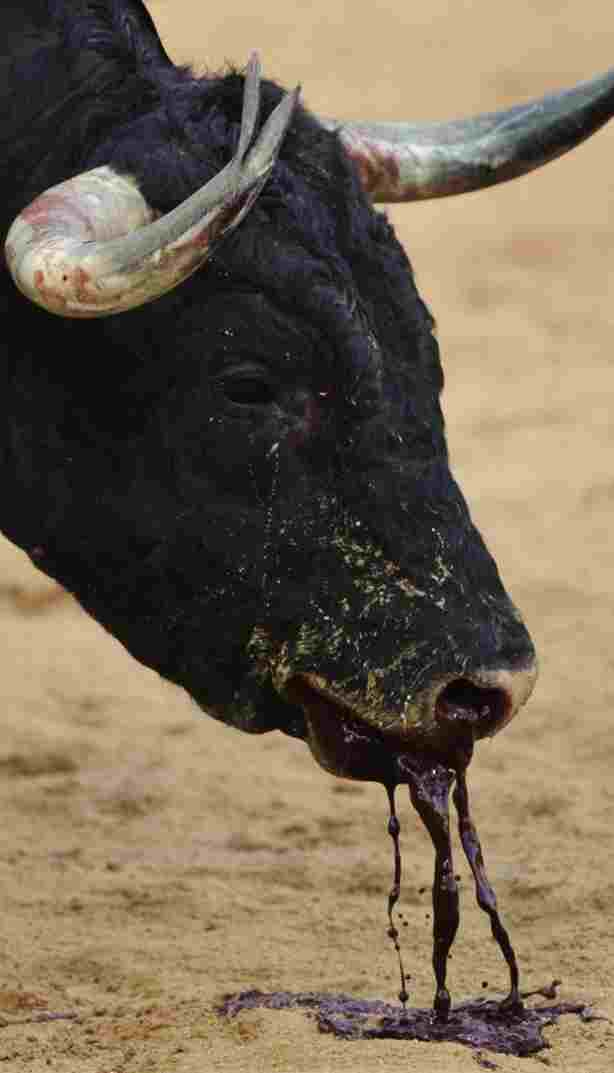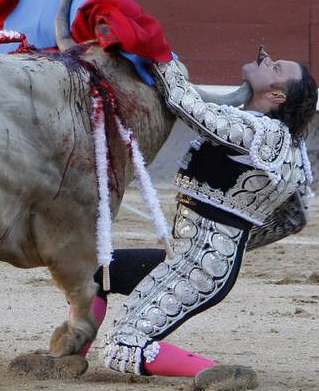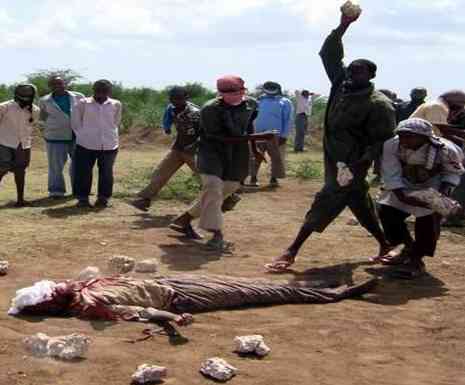While
in Mexico (Barra de Navidad) over the Christmas holidays, in a
$35/night hotel room that included a small kitchen
and living room, AC and cable TV, I had watched (forgoing sun and sea),
during the holy Navidad weekend, no less than 20 gloriously gory,
one-sided altercations between matador and bull, and was now in the
mood for the real thing.
 When one of the Barra locals (un policía) explained
that in Cihuatlán, the nearest town with a Plaza
de Toros, they don’t kill the bull, I couldn’t
help but register huge disappointment. In point of fact
my blood began to boil: the nerve, the outrageous pretense
of sparing bull in a country that fessed up to 13,000 drug-related
deaths in 2011. My interlocutor, no doubt, was equally disappointed,
there being no basis for extracting a ‘tip’
from our brief question and answer summit. But it was a
sleepy day in this tranquil coastal town of 5,000, so, on
my behalf, he phoned Cihuatlán and assured me that
there would indeed be ‘no blood’ on Sunday and
festivities begin at 5 pm. A week later, he would be investigating
a murder in the nearby town of Melaque, where Scottish-Canadian
citizen Robin Wood was killed in a botched burglary.
When one of the Barra locals (un policía) explained
that in Cihuatlán, the nearest town with a Plaza
de Toros, they don’t kill the bull, I couldn’t
help but register huge disappointment. In point of fact
my blood began to boil: the nerve, the outrageous pretense
of sparing bull in a country that fessed up to 13,000 drug-related
deaths in 2011. My interlocutor, no doubt, was equally disappointed,
there being no basis for extracting a ‘tip’
from our brief question and answer summit. But it was a
sleepy day in this tranquil coastal town of 5,000, so, on
my behalf, he phoned Cihuatlán and assured me that
there would indeed be ‘no blood’ on Sunday and
festivities begin at 5 pm. A week later, he would be investigating
a murder in the nearby town of Melaque, where Scottish-Canadian
citizen Robin Wood was killed in a botched burglary.
For
all the laudatory, madly inspired tomes written on the high
art of bullfighting, consider the fact that the average
bull is worth 35 litres of blood. If it dies a deliciously
slow death at the hands of an incompetent torero
(matador), it’ll leak about 10 litres of that amount.
Which means on a good day the spectator will be treated
to 100 litres of spilled blood, which, in theory, should
be enough to get the afición from Sunday
to Sunday without having to seek out alternative sources.
 So when I aver that I was in the mood for blood, I wanted to see
-- and without apology -- a veritable blood bath, the earth
turn rojo and watch bulls (and matadors) die a
slow death.
So when I aver that I was in the mood for blood, I wanted to see
-- and without apology -- a veritable blood bath, the earth
turn rojo and watch bulls (and matadors) die a
slow death.
To
finger-quick readers who have already crossed me off their lists and
assigned me to the category of unregenerate, blood-thirsty savage, I
propose that my lust for blood is not an isolated perversion. Where
good society hasn’t banned the sport, the bull rings are full to
capacity and the red dye used in T-shirt manufacture is certified
organic.
Is
it beyond the pale to suggest that human beings are most likely to rise
to the occasion of authenticity when gathered as a punitive mob or
assembled to witness a blood-letting?
What
draws (after Holy Communion) the empirically vampiric to the bull ring
is the same that makes a heavyweight championship fight the most
watched event on the planet, that brings many to near delirium during a
Formula I crash, and bids millions to watch replays of the most
horrible accidents and crimes (Challenger exploding, the collapse of
the Twin Towers). During a big boxing match, crime rates drop by 25% worldwide. It seems
that everyone everywhere can’t get enough of blood, gore and
death, all of which suggests that the regrettably retired Roman
Coliseum, as a state of mind, is enjoying an afterlife that dwarfs that
of the Nazarene’s now relegated to the rites of Sunday school and
cheerless Church ceremony.
The
blunt and brutal fact of the matter is that we, especially men, like to
watch things die (the slower the better) and are prepared to spend
considerable sums of money for that very particularized pleasure. Like
deer frozen in bright headlights at night, we are fascinated by death.
As an autopsy-resistant event shrouded in mystery, death is both the
bewitching darkness at noon we cannot refuse and gravitational force
against whose escape velocity the mind is no match.
We
are a species that hungers to know. We are wired to invest our energies
and three score and ten endeavouring to make known the unknown, and are
rewarded, that is relieved of the fear and anxiety aroused by the
unknown, when we succeed. Our obsession with dangerous sports speaks to
that hunger. But since death is existentially unknowable, we are fated
to be left on the edges of our seats looking into the abyss, into the
cloudy eyes of the bull and boxer on their way out – and no
farther. Like Sisyphus condemned forever to roll the rock up the hill
only to have it roll down again and again, there shall be no purchase
on death no matter how many bull fights or boxing matches we attend.
 Does the mystery of death recede the closer we get to it, and like
a feel-good drug over time, we require more of it for the
same effect? The number of new
extreme and dangerous sports has increased
exponentially during the past 25 years, amplified by the
proliferation of cable and satellite TV that now bring lethal
combat to the remotest regions of the planet.
Does the mystery of death recede the closer we get to it, and like
a feel-good drug over time, we require more of it for the
same effect? The number of new
extreme and dangerous sports has increased
exponentially during the past 25 years, amplified by the
proliferation of cable and satellite TV that now bring lethal
combat to the remotest regions of the planet.
Left
to our own devices, how many of us would rip up a ticket to a man
versus lion mismatch, or snub the opportunity to view a snuff film,
where the actor, usually female, gets killed during the making of the
film, or stay home to watch replays of I Love Lucy while a public
hanging is taking place? What compels us to sports where death is
either a promise or a possibility is not the inner savage having its
way, but our insatiable curiosity to know about death so to better
prepare for our own.
There
is much to be learned watching ourselves watching bulls and boxers die
or drop. For the occasion of the matador’s final thrust, an
inexpert estocado will puncture the bull’s lung instead
of the aorta. The animal, bleeding at the shoulders and neck, vomiting
torrents of blood, will wobble, shudder, crumple and die. It is the
breathless, euphoric moment in the sport that everyone pays for. In the
case of the boxer who has been bloodied, staggered and KO’d,
there is perhaps nothing more satisfying in all of sport than watching
the fighter resurrect himself off the canvas and come back to fight
another round, a spectacle that rivals the comeback around which
Christianity was founded.
That
we are a transcendent species is a proposal the facts on the ground
cannot support. With a nod to Plato and observable human behaviour
throughout the ages, it seems that the mind is at the service of the
passions -- and not the other way around.
With
all due respect to the awe and humility I have experienced in the
presence of the great achievements in the arts and humanities, it was
while watching bulls expire in the pools of their blood that left me
feeling unprecedentedly alive and vital, giddy and shaken and gasping
for breath. It was not Fra Angelico’s “Annunciation”
but bull’s blood that made me see that the enduring truth of
blood sport is revealed not in the ring but in the collective response
of the spectator for whom the vicarious experience of death or near
death produces the opposite, animating effect. “The one thing we
seek with insatiable desire is to forget ourselves, to be surprised out
of our propriety,” writes Emerson. In a sound and fury that
borders on ecstasy, which just happens to be the name of a drug, what
is invariable in the spectator response to near death moments in sport
is the obliteration of self-consciousness and the rapturous
light-headedness that takes over.
Whatever
medical indices one adduces to measure life potency, in the presence of
a blood fiesta a crowd’s numbers go off the charts and into the
adrenalinsphere, effectively diminishing the predictive value of the
law of diminishing returns. Chiseled into the distorted, frenzied face
of any audience singularized by its fascination with death is the
understanding that all human endeavour reduces to “the eternal
recurrence of the same;” meaning after the last bull has been
killed, the last boxer dropped, the enigma of death still remains,
which predicts we shall not cease from knocking on heavens door –
until we gain entry.
No
surprise to observe that the rites of death are renewed and re-enacted
everyday everywhere on the planet. And in those rooms where people come
and go, talking of Michelangelo, well, my hunch is that they are just
passing time waiting for the next bull to be let out.
 When Islam calls for the public stoning to death of its
sinners (usually female), two fundamental desiderata are being
addressed. The impure sinner is expeditiously removed from the
collective (with the example serving as a warning to others), and the
crowd’s curiosity about death is temporarily stayed.
When Islam calls for the public stoning to death of its
sinners (usually female), two fundamental desiderata are being
addressed. The impure sinner is expeditiously removed from the
collective (with the example serving as a warning to others), and the
crowd’s curiosity about death is temporarily stayed.
Despite
personal issues with radical Islam’s propensity to convert its
most vulnerable into human bombs and treat its women like chattel, the
tradition of public stoning, as a more fully realized expression of
bull fighting and boxing, is a reminder that good and evil are best
worked out in the context of pluralism. Short of outrightly converting,
there may very well come a day when I will judge myself as having lived
incompletely (inauthentically) in the absence of witnessing a live
stoning.
* * * * * * * * * *
If
the above portrait is accurate in the way it speaks to what
is universal in the species response to lethal sport, and
makes us cover our eyes in shame, what can we do to remake
ourselves to better please the eye? How are we to rise above
the imperatives of our genotype? What must happen to make
us want to command ourselves to stand still before the mirror
and take into full account what is there: an unhappy, confused,
self-loathing creature whose flabby, slothful mind has been
no match against the tried and tested straight-arm of human
nature? Of the many questions we ask of ourselves everyday
over the course of a lifetime, are some more essential than
others? What questions, if any, do an endangered species
proud?
As
much as I still occasionally get caught up in the frenzy of blood
sport, by far and away my favourite contest is between reason and human
nature, in part, because it’s a game I get to play everyday, and
that the former now enjoys winning streaks that are becoming longer and
more frequent with each passing year. Last but not least, this is a
team sport, which implicates the Internet (the word) in ways that were
previously unimaginable, and everyone can play.
So
for all of us "at play in the fields of the Lord," I say go team go,
for there will soon come a time when losing will not be an option.